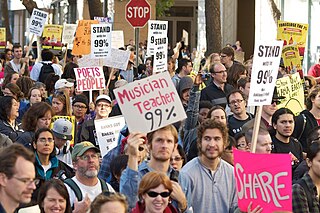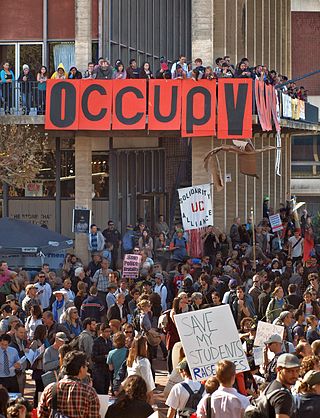Occupy The Rose Parade (OTRP) was a four phase Occupy demonstration and protest by approximately 10,000 Occupy Movement activists that was held on January 1 and January 2, 2012 as part of the Occupy movement at the Tournament of Roses Parade in Pasadena, California held on January 2, 2012. The main organizer of the 2012 OTRP, Pete Thottam, is a Los Angeles based Occupy volunteer, attorney and longtime antiwar activist. Phase 1 of the demonstration was on Sunday, January 1. It was organized by a separate group from the Occupy Pasadena group protesting locally, with no affiliation or endorsement between the two although a number of members of Occupy Pasadena actively participated in and helped organize the Occupy The Rose Parade demonstration. Rose Parade and Pasadena officials authorized the Occupy the Rose Parade movement to march at the end of the parade, after all the floats have passed and the phalanx of police cars moves through, but while the crowd is still in place. [1]
The protest's central human float action was a peaceful and nonviolent protest with no arrests. Organizers worked with the City of Pasadena, Official Tournament of Roses Parade organizers and the Pasadena Police. [2] [3]
The Rose Parade, in person, has an annual audience of a million people, and a worldwide television audience on multiple networks. [4] On the day of the event, the worldwide television broadcast cut to the announcers in the booth, eliminating any coverage of the protestors. [5] [6] Live streaming presented the event over the internet. [7]
Among the speakers at the January 1 and January 2 protest and demonstrations included Reverend Bacon (All Saints Pasadena Church), Martin Sheen, Ed Asner, Carlos Marroquin (U.S. Foreclosure Activist), Ellen Brown (Web of Debt & Public Banking advocate), John Goodman (California Clean Money Campaign), Peter Thottam, Daniel Wayne Lee (Move To Amend Co-Chair), Marcy Winograd, Cindy Sheehan, Michelle Shocked, singer Laura Love and singer Jackson Browne, and other nationally recognized Occupy activists and their supporters from around the country.[ citation needed ] The speakers and protest action sought primarily to emphasize "Corporate Money out of Politics," "Stopping Foreclosures," and "Ending Corporate Personhood" messages of Occupy Wall Street and, more broadly, to put spotlight on what activists state is a dysfunctional U.S. system with growing economic and social justice concerns that have reached crisis proportions in the U.S.
On November 11, 2011, on their website the organizers stated "...we will in no way obstruct the path of the Rose Parade. This will be a peaceful and non-violent but spectacular protest of Occupiers everywhere calling for campaign finance reform and broader systemic reforms."
That same day, conservative website Breitbart.tv reported that Occupy Rose Parade intended to disrupt the Rose Parade. [8]

Pasadena is a city in Los Angeles County, California, United States, 11 miles (18 km) northeast of downtown Los Angeles. It is the most populous city and the primary cultural center of the San Gabriel Valley. Old Pasadena is the city's original commercial district.

The Rose Parade, also known as the Tournament of Roses Parade, is an annual parade held mostly along Colorado Boulevard in Pasadena, California, United States, on New Year's Day.

The Chicano Moratorium, formally known as the National Chicano Moratorium Committee Against The Vietnam War, was a movement of Chicano anti-war activists that built a broad-based coalition of Mexican-American groups to organize opposition to the Vietnam War. Led by activists from local colleges and members of the Brown Berets, a group with roots in the high school student movement that staged walkouts in 1968, the coalition peaked with a August 29, 1970 march in East Los Angeles that drew 30,000 demonstrators. The march was described by scholar Lorena Oropeza as "one of the largest assemblages of Mexican Americans ever." It was the largest anti-war action taken by any single ethnic group in the USA. It was second in size only to the massive U.S. immigration reform protests of 2006.

The Pasadena Police Department is the police department serving Pasadena, California. The headquarters of the Pasadena Police Department is located at 207 North Garfield Avenue in Pasadena, just a block from the Pasadena City Hall and Paseo Colorado. The department employs 241 sworn officers, 13 reserve officers, and 126 civilian employees. Police chief John Perez, who spent his entire career with the department, retired and was replaced by former PPD Commander, now interim Chief Jason Clawson. The city has selected former San Gabriel, CA PD Chief Eugene Harris to take the position in January 2023.
The Rose Palace, also known as the Pasadena Rose Palace, was a building located at 835 South Raymond Avenue in the city of Pasadena, California. It was built by the Pasadena Tournament of Roses Association in 1964.

William Mihrtad Paparian is an American politician, a former mayor of Pasadena, California, serving from 1995 to 1997. He was also a member of the Pasadena City Council from 1987 to 1999, and a Green Party candidate for Congress in 2006. He was the first Armenian-American mayor of Pasadena, as well as the only Pasadena mayor to visit Cuba during his term. Paparian has been known throughout his political career as an outspoken advocate of controversial causes, including ending the trade embargo against Cuba. He attracted national media attention for dispatching a Pasadena police helicopter to issue a citation to state aircraft spraying pesticides over the city, and for his urging Rose Parade observers in 2008 to turn their backs on the Chinese float, which he called the "Beijing Float of Shame."

Occupy Los Angeles is one of the many occupy movements in the United States, following the original Occupy Wall Street (OWS) protest. Participants of Occupy L.A. first met at Pershing Square on September 23, 2011. Activists came to consensus to occupy public space in solidarity with the growing movement. Occupiers first marched in Los Angeles on September 24, 2011. They next protested a fundraiser being held in Hollywood at the House of Blues for President Obama. Participants met at Pershing Square every subsequent night to plan out the logistics of an occupation set to begin on October 1, 2011. After debating potential locations around Los Angeles, people decided on the lawns around City Hall. Tents first manifested on October 1, 2011 on the grounds of Los Angeles City Hall.

Occupy Portland was a collaboration that began on October 6, 2011 in downtown Portland, Oregon as a protest and demonstration against economic inequality worldwide. The movement was inspired by the Occupy Wall Street movement that began in New York City on September 17, 2011.

The Occupy movement was an international populist socio-political movement that expressed opposition to social and economic inequality and to the perceived lack of real democracy around the world. It aimed primarily to advance social and economic justice and different forms of democracy. The movement has had many different scopes, since local groups often had different focuses, but its prime concerns included how large corporations control the world in a way that disproportionately benefits a minority, undermines democracy and causes instability.

Occupy Buffalo was a collaboration that included a peaceful protest and demonstrations which began on October 1, 2011, in Buffalo, New York, in Niagara Square, the nexus of downtown Buffalo opposite the Buffalo City Hall. It is related to the Occupy Wall Street movement that began in New York City on September 17, and called for economic equity, accountability among politicians and ending lobbyist influence of politicians. Protesters camped overnight in Niagara Square as part of the demonstration.

Occupy Oakland refers to a collaboration and series of demonstrations in Oakland, California, that started in October 2011. As part of the Occupy movement, protesters have staged occupations, most notably at Frank H. Ogawa Plaza in front of Oakland City Hall.

Occupy San Francisco was a collaboration that began with a demonstration event located at Justin Herman Plaza in the Embarcadero and in front of the Federal Reserve building on Market Street in the Financial District in San Francisco, California. It is based on the Occupy Wall Street movement that began in New York City on September 17, 2011 and is one of several "Occupy" protest sites in the San Francisco Bay Area; other sites include Occupy Oakland and Occupy San Jose.

The Occupy movement began in the United States initially with the Occupy Wall Street protests in New York City, but spread to many other cities, both in the United States and worldwide. This list article is an alphabetical, non-chronological summary of Occupy events that have occurred in cities in the United States.

Occupy Cal included a series of demonstrations that began on November 9, 2011, on the University of California, Berkeley campus in Berkeley, California. It was allied with the Occupy Wall Street movement in New York City, San Francisco Bay Area Occupy groups such as Occupy Oakland, Occupy Berkeley, and Occupy San Francisco, and other public California universities. "Cal" in the name "Occupy Cal" is the nickname of the Berkeley campus and generally refers specifically to UC Berkeley.

Occupy Baltimore was a collaboration that included peaceful protests and demonstrations. Occupy Baltimore began on October 4, 2011, in Baltimore, Maryland, in McKeldin Square near the Inner Harbor area of Downtown Baltimore. It is one of the many Occupy movements around the United States and worldwide, inspired by Occupy Wall Street.

The UC Davis pepper spray incident occurred on November 18, 2011, during an Occupy movement demonstration at the University of California, Davis. After asking the protesters to leave several times, university police pepper sprayed a group of student demonstrators as they were seated on a paved path in the campus quad. The video of UC Davis police officer Lt. John Pike pepper-spraying demonstrators spread around the world as a viral video and the photograph became an Internet meme. Officer Alex Lee also pepper sprayed demonstrators at Pike's direction.

Occupy Homes or Occupy Our Homes is part of the Occupy movement which attempts to prevent the foreclosure of people's homes. Protesters delay foreclosures by camping out on the foreclosed property. They also stage protests at the banks responsible for the ongoing foreclosure crisis, sometimes blocking their entrances. It has been compared to the direct action taken by people to prevent home foreclosures during the Great Depression in the United States.

Occupy Redwood City was a collaboration that began with peaceful protests, demonstrations, and general assemblies in front of the historic San Mateo County Courthouse in Redwood City, California. The demonstration was inspired by Occupy Wall Street and is part of the larger "Occupy" protest movement.

Occupy Minneapolis (OccupyMN) is a grassroots collaboration that began in October 2011 with a series of demonstrations in Minneapolis, Minnesota. Protesters have staged numerous occupations, most notably of the Hennepin County Government Center plaza.